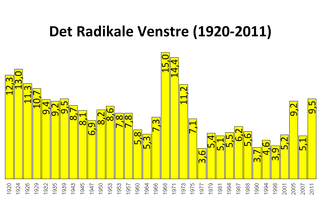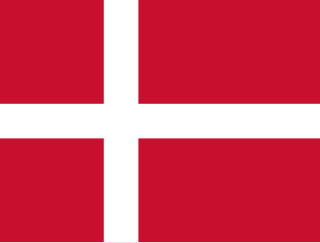
The Socialist Left Party or SV, is a democratic socialist political party in Norway.

The Socialist People's Party is a green and popular socialist political party in Denmark.
Venstre, full name Venstre, Danmarks Liberale Parti, is a conservative-liberal, agrarian political party in Denmark. Founded as part of a peasants' movement against the landed aristocracy, today it espouses an economically liberal pro-free market ideology.
The Conservative People's Party, also known as the Conservatives is a conservative centre-right political party in Denmark. The party is a member of the European People's Party (EPP) and International Democrat Union.
The Social Democrats, officially Social Democracy, is a social-democratic political party in Denmark. It was the major coalition partner in government from the 2011 parliamentary election, with then-party leader Helle Thorning-Schmidt as Prime Minister. After the 2015 parliamentary election, the party is no longer in government, though it regained the position as the largest party in the Danish parliament, the Folketing, with 47 of 179 seats. Helle Thorning-Schmidt withdrew as party leader on the night of the election as a direct consequence of the loss of government control, and she was succeeded on 28 June 2015 by the former vice leader, Mette Frederiksen.
The Danish People's Party (DPP) is a political party in Denmark which is generally described as right-wing populist by academics and far-right by international media. It has also been described in academia and the media as a nativist and anti-immigrant party. The party was founded in 1995 by Pia Kjærsgaard, who was the leader of the party until 2012, when she passed the leadership on to Kristian Thulesen Dahl. The DPP lent its support to the Liberal-Conservative government from the general election of 2001 until the 2011 election defeat. While not part of the cabinet, DPP cooperated closely with the governing coalition on most issues and received support for key political stances in return, to the point that the government was commonly referred to as the "VKO-government".
The Red–Green Alliance is an eco-socialist political party in Denmark. It is the furthest left party in the Danish Parliament, advocating for socialist democracy in Denmark and internationally.

The Danish Social Liberal Party is a social-liberal political party in Denmark. The party is a member of Liberal International and the Alliance of Liberals and Democrats for Europe (ALDE).
There are three types of elections in Denmark: elections to the national parliament, local elections and elections to the European Parliament. Referendums may also be called to consult the Danish citizenry directly on an issue of national concern.

Aarhus Municipality, until 2011 formerly known as Århus Municipality, is a municipality in Central Denmark Region, on the east coast of the Jutland peninsula in central Denmark.

The Danish Folketing election of 1915 was held on 7 May 1915. As required to change the Constitution, the government called for the dissolution of both the Folketing and the Landsting in order for the new Rigsdag to be able to introduce the new constitution. However, as this was during World War I, no campaigning took place, and the election was settled without voting in 104 of 114 constituencies. Therefore, it is impossible to give numbers for the actual support the respective parties received from the voters.
The Liberal Alliance is a liberal, right-libertarian political party in Denmark.
Country-wide local elections for seats in municipality and county councils were held throughout Norway in 1999. For most places this meant that two elections, the municipal elections and the county elections ran concurrently.
The Danish local elections of 2005 were held on 15 November 2005. 2522 municipal council members were elected in Denmark's 98 municipalities and 205 regional council members in the five regions. Most of these were newly formed municipalities, namely 66 municipalities, that would only begin working from Monday 1 January 2007, as would the newly formed regions, and one municipality, Ærø, which was also part of the reform, which was allowed by the government to commence work for the first time already Sunday 1 January 2006. So the first term of office in this newly created municipality was the whole period of four years from 2006 until 2009. The 238 municipal councils and 13 county councils that were to be abolished 1 January 2007 just continued their work one year more than the term of office (2002-2005) they were elected for until 31 December 2006 and then ceased to exist. Among the remaining 31 municipalities having their new councils elected was Bornholm Regional Municipality that was formed and began its work 1 January 2003. This was only the second time it had a new council elected, the first time being in November 2001, and it was the first time its council served the whole term of office. Bornholm's merger was not a part of the reform, having been decided by the island's voters already in May 2001. It was the new center-right government elected at the end of 2001 that drove the reform through parliament. The 30 municipalities that remained were not merged with other municipalities, so their newly elected councils served the whole term of office 1 January 2006 until 31 December 2009.
The Danish local elections of 2013 were held on 19 November 2013 in Denmark's 98 municipal councils, contesting 2,444 seats for the 2014-17 term of office, and in five regional councils, contesting 205 seats for the 2014-17 term. Advance voting began on 20 August 2013 in national registration offices in Denmark, hospitals, prisons etc. Twelve (12) women hold the highest political office of mayor in the municipalities in the 2014-17 term of office.

General elections will be held in the Kingdom of Denmark after either the dissolution or expiry of the current Parliament, and must be held on or before 17 June 2019. All 179 members of the Folketing will be elected. 175 members will be elected in Denmark proper, two in the Faroe Islands and two in Greenland.

The Alternative is a green political party in Denmark. The party was publicly launched on 27 November 2013 by former Minister of Culture Uffe Elbæk and Josephine Fock, both of whom had been Members of Parliament for the Social Liberal Party.
The Danish local elections of 2001 were held on 20 November 2001. 4647 municipal council members were elected to 271 municipal councils, as well as members of 13 counties of Denmark. Previously, there were 14 counties and 275 municipalities, but the county of Bornholm was merged with its 5 constituent municipalities 1 January 2003 to form Bornholm Regional Municipality. The voters of Bornholm elected the councillors in this election to lead the new entity from January 2003. The county and county council of Bornholm just continued its work until 2002 while the new Bornholm Regional Municipality was being built from the 6 old entities. From 1 January 2003 until 31 December 2006, Bornholm was both a municipality and a county, thereafter becoming a part of Region Hovedstaden and losing most of its county privileges.
The Danish local elections of 1997 were held on 18 November 1997. 4685 municipal council members were elected to the 1998 - 2001 term of office in the 275 municipalities, as well as members of the 14 counties of Denmark.
The Danish local elections of 2017 were held on 21 November 2017 for Denmark's 98 municipal councils and five regional councils. All 2,432 seats were contested for the 2018–21 term of office, together with 205 seats in five regional councils. In the previous election, there were 2,444 seats in the municipal councils. Some foreigners can also vote in regional and local elections, but not at the national level.









